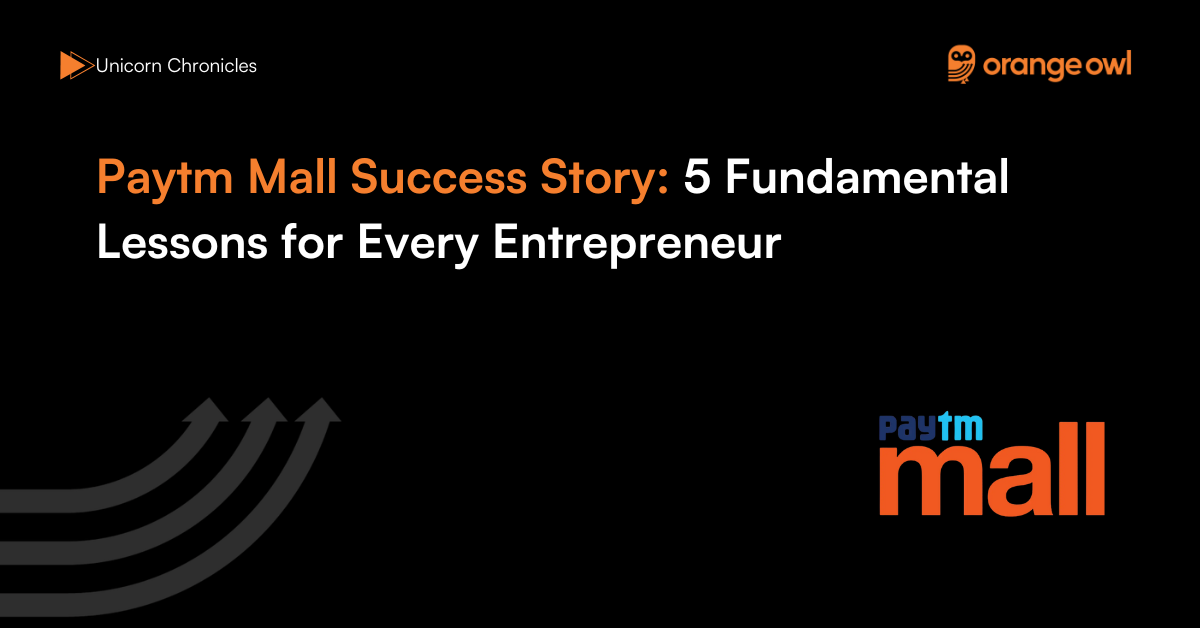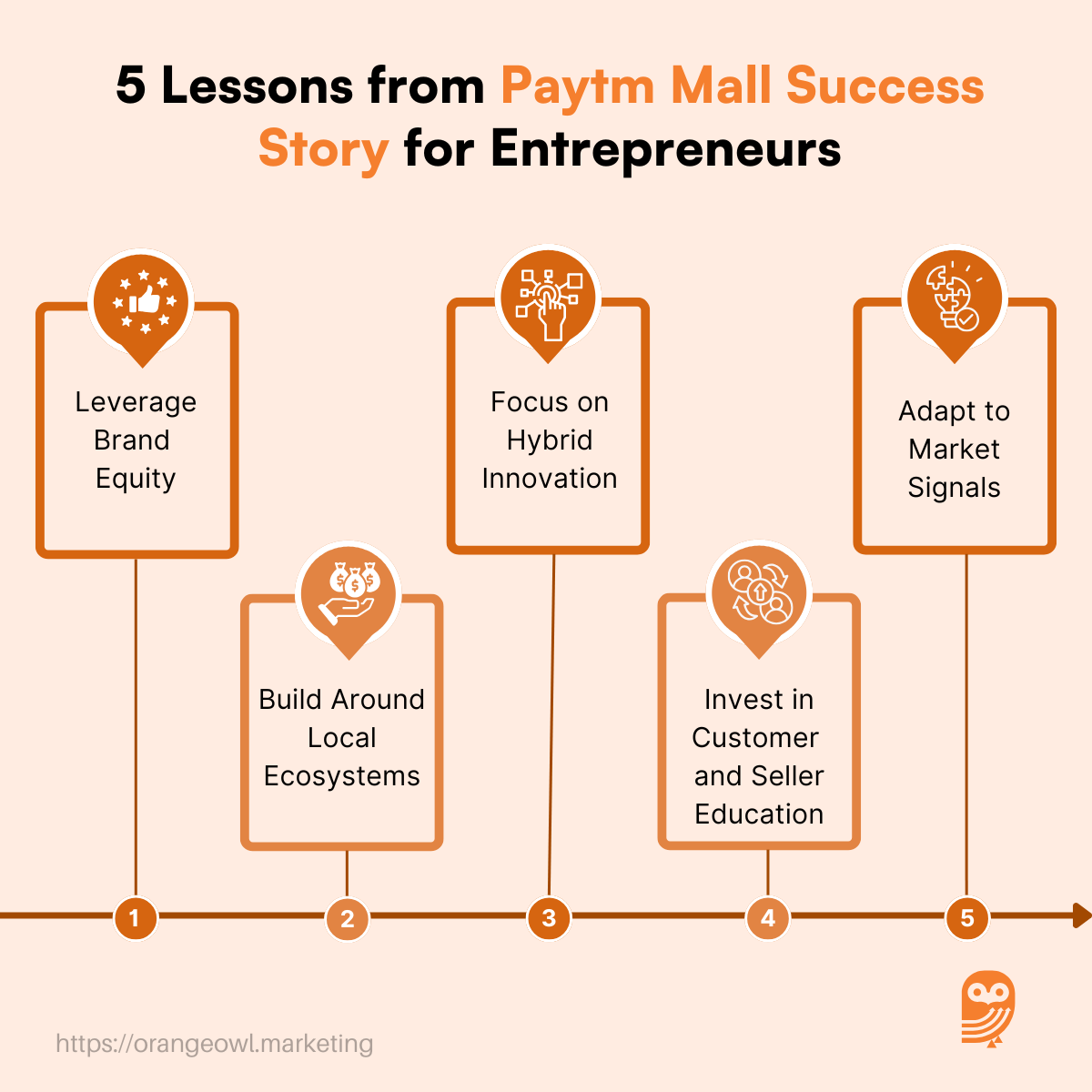Paytm Mall Success Story: 5 Fundamental Lessons for Every Entrepreneur
Vivek Goel
May 21, 2025

Table of Contents
Introduction: Bridging Online and Offline Retail in India
In 2017, Paytm, India’s leading digital payments platform, ventured into the e-commerce sector by launching Paytm Mall. Backed by significant investments from global giants like Alibaba and SoftBank, the initiative aimed to integrate the efficiency of online shopping with the trust and familiarity of offline retail. The vision was clear: empower local shopkeepers by bringing them online, offering consumers a vast catalog of products ranging from electronics and fashion to groceries and home essentials.
Within a year of its inception, Paytm Mall achieved unicorn status, securing a valuation of approximately $1.9 billion. This milestone was marked by a substantial funding round in April 2018, where SoftBank invested $400 million and Alibaba contributed $45 million, underscoring global confidence in Paytm Mall’s hybrid retail model .
The platform’s unique approach focused on integrating India’s vast offline retail network into the digital ecosystem. By leveraging Paytm’s existing user base and introducing innovative solutions like QR-code-based commerce, Paytm Mall positioned itself as a formidable Indian alternative to e-commerce giants like Amazon and Flipkart.
“Our goal was to digitize physical retail, not replace it. We wanted to give local shopkeepers the same tools that e-commerce giants had.” — Amit Sinha, COO, Paytm Mall
Origin Story: From Payments to Products
By 2016, Paytm, under the visionary leadership of Vijay Shekhar Sharma, had already revolutionized India’s digital payments landscape. With a strong foothold in the mobile wallet space and a rapidly growing user base that surpassed 100 million users, the next logical step was to enter the e-commerce domain. Thus, in 2017, Paytm Mall was launched, drawing inspiration from Alibaba’s Tmall—a model known for its blend of online convenience and offline retail reliability.
Co-led by Amit Sinha, Paytm Mall aimed to create a phygital (physical + digital) ecosystem that connected India’s traditional retailers with tech-savvy consumers. The founders envisioned a model where local kirana stores, electronics vendors, and apparel sellers could all participate in the digital economy without the overheads or disruption associated with typical e-commerce marketplaces.
At its core, the platform allowed offline merchants to digitize their inventory using QR codes, which customers could scan to explore product catalogs, make purchases, and even access exclusive online discounts—all while shopping from their trusted local stores. This approach significantly lowered the entry barrier for SMEs and gave Paytm Mall a unique value proposition in India’s bustling e-commerce landscape.
The platform started by focusing on high-demand categories like electronics, fashion, FMCG, and groceries, quickly onboarding thousands of sellers across India. By leveraging Paytm’s existing mobile wallet infrastructure and consumer trust, Paytm Mall provided an integrated shopping experience that merged digital payments, local fulfillment, and competitive pricing—all within a single app.
Business Landscape and Challenges
Paytm Mall entered the Indian e-commerce space at a time when the market was fiercely dominated by Amazon and Flipkart, both of which had already established robust infrastructure, deep discounting strategies, and loyal customer bases. In such a competitive environment, building differentiation was crucial—but it also came with a unique set of challenges.
One of the primary hurdles was customer acquisition and retention. While Paytm had a massive user base through its payments platform, converting those users into regular online shoppers required more than cross-platform visibility. Deep discounts and same-day delivery had become the norm, and competing with giants who had already mastered those operations was tough.
Another significant challenge lay in seller onboarding and enablement. Paytm Mall’s strategy relied heavily on digitizing small and medium-sized businesses. However, educating these retailers on inventory digitization, managing digital storefronts, and adhering to online fulfillment expectations was a daunting task. Many local sellers were new to technology, which led to slower adoption rates and operational inconsistencies.
Logistics posed yet another roadblock. To fulfill orders across Tier 2 and Tier 3 cities, while keeping costs low and returns manageable, Paytm Mall had to rethink traditional e-commerce logistics. It deployed a hybrid logistics model, partnering with both national and regional courier services, and set up local fulfillment centers to ensure timely deliveries and better return handling.
To instill consumer trust, Paytm Mall introduced a ‘Verified Seller’ program, which included stringent quality checks, return policies, and after-sales support. This helped build credibility among customers wary of new platforms and ensured a more reliable shopping experience.
“We believed India needed an e-commerce model that supported the corner shop and made the technology work for them.” — Vijay Shekhar Sharma, Founder, Paytm
Despite these challenges, Paytm Mall continued to innovate and iterate, carving a niche for itself by prioritizing retail inclusivity, localized engagement, and digital empowerment for India’s vast offline retail segment.
Growth Strategies: Digitizing Local Retail
A cornerstone of Paytm Mall’s growth strategy was its bold attempt to bridge India’s massive offline retail network with the digital economy. At the heart of this was the QR-code commerce model, where each participating local shopkeeper was provided with a unique QR code. Customers could walk into a nearby store, scan the code, browse the store’s digital inventory on Paytm Mall, and place an order—creating a seamless online-offline retail experience.
This model not only extended e-commerce’s reach to millions of mom-and-pop stores (kirana shops) across India but also lowered the technology barrier for merchants with limited digital infrastructure. By blending the trust of in-person interactions with the convenience of online shopping, Paytm Mall built a hybrid ecosystem that was unique in the Indian e-commerce landscape.
To scale this model, the company invested significantly in technology and data science. Through machine learning algorithms, it enabled hyper-personalized product recommendations, dynamic pricing, and targeted promotions. On the merchant side, these tools helped retailers manage their inventory better, predict demand, and automate reordering—empowering them to operate more efficiently in the digital space.
Another major strategic thrust was assisted commerce experiences. Paytm Mall partnered with electronics retailers, fashion outlets, and grocery chains to offer in-store support for digital shopping, especially in Tier 2 and Tier 3 cities, where trust in digital platforms was still evolving.
In terms of fundraising, the platform raised a substantial $650 million in 2018, led by Alibaba and SoftBank, resulting in a post-money valuation of $1.9 billion and officially making Paytm Mall a unicorn. These funds were directed toward:
- Expanding the seller base across underserved markets.
- Enhancing logistics infrastructure with regional warehouses.
- Improving product assortment across categories like electronics, home décor, and FMCG.
- Launching aggressive incentives for merchants and cashback-driven loyalty programs for consumers.
Marketing Strategy: Focused on Trust and Localization
In a market where customer trust and regional familiarity are pivotal, Paytm Mall’s marketing strategy was deeply rooted in localization and credibility. Instead of simply positioning itself as a product marketplace, Paytm Mall framed its narrative around community commerce—the idea that users could now shop online from the same neighborhood stores they’ve always trusted.
The campaign message “Buy from your trusted local shopkeeper—online” struck a chord in India’s semi-urban and rural regions, where the social connection with retailers remains strong. This hybrid model helped overcome skepticism toward faceless e-commerce platforms, especially among first-time internet users.
To bolster this connection, Paytm Mall:
- Localized marketing campaigns in multiple Indian languages.
- Ran targeted promotions during key regional festivals such as Onam, Pongal, and Diwali, often with exclusive festive deals and cashback offers.
- Collaborated with local influencers and regional celebrities to drive trust and visibility in specific geographies.
- Sponsored retail partnerships and co-branded offline promotions to generate footfall and app downloads.
Another key element of its marketing was financial ease and integration. Since the platform was tightly integrated with Paytm Wallet, UPI, and later Paytm Postpaid, customers enjoyed frictionless checkouts. This simplicity helped convert digitally hesitant shoppers into loyal e-commerce buyers.
During high-traffic seasons such as the Great Indian Festival and Independence Day Mega Sale, Paytm Mall rolled out nationwide TV ads, digital campaigns, and influencer promotions, all tied back to themes of local pride, reliability, and festive savings.
“We weren’t trying to be another Amazon or Flipkart. Our goal was to build an e-commerce ecosystem where local businesses could thrive in the digital age.”— Amit Sinha, COO, Paytm Mall
5 Fundamental Lessons for Every Entrepreneur
1. Leverage Brand Equity
When Paytm Mall entered the e-commerce space, it had a significant advantage that most startups don’t—brand trust and a massive user base from its parent company, Paytm. This existing credibility helped accelerate user adoption and merchant onboarding. The platform didn’t need to build awareness from scratch; instead, it leveraged the familiarity and confidence consumers already had in Paytm’s payment services. This highlights a key entrepreneurial lesson: when expanding into new verticals, a strong parent brand can significantly reduce acquisition costs and build instant trust.
2. Build Around Local Ecosystems
Rather than disrupting the traditional retail network, Paytm Mall sought to enable it digitally. Its core strategy revolved around uplifting local retailers by giving them access to online customers and tools to digitize their inventory and transactions. This inclusive model not only fostered loyalty among merchants but also resonated with consumers who preferred buying from nearby stores. The lesson? Building solutions that empower existing ecosystems is often more sustainable than trying to replace them.
3. Focus on Hybrid Innovation
Paytm Mall’s biggest innovation was its phygital (physical + digital) approach. By enabling customers to shop from local stores online using QR codes and offering digital catalogs backed by real-world retail, it combined the best of both channels. This hybrid strategy was tailored for India’s unique retail environment, where physical retail is deeply rooted but digital access is rapidly expanding. For entrepreneurs, this underlines the importance of contextual innovation—solutions must align with the realities of the market.

4. Invest in Customer and Seller Education
To scale a technology-led platform that relied on traditional businesses, Paytm Mall had to do more than provide tools—it had to teach merchants how to use them effectively. Training sellers on listing products, managing digital payments, and fulfilling orders was integral to ensuring quality and consistency. Likewise, educating new online buyers on safe payments and returns helped reduce friction. This shows that education and enablement should be central to product adoption, especially in emerging markets.
5. Adapt to Market Signals
Despite its early consumer-facing ambitions, Paytm Mall eventually pivoted toward B2B commerce, prioritizing profitability and sustainability. The decision to evolve its business model in response to market dynamics, competitive pressures, and consumer behavior is a valuable lesson in agility. Founders must remain open to change and avoid becoming emotionally attached to a specific vision.
“You can’t be romantic about your strategy. You have to listen to your customers and change course when needed.” — Vijay Shekhar Sharma, Founder, Paytm
Conclusion
Paytm Mall’s journey is a compelling example of how technology can be used not just to disrupt, but to include and uplift. In a market dominated by large players, Paytm Mall carved its own identity by blending the trust of local retail with the power of digital commerce. Its QR-code commerce model, regional seller empowerment, and deep integration with financial infrastructure reflect a vision that was bold, India-first, and deeply rooted in local relevance.
While the company faced stiff competition, logistical hurdles, and shifts in consumer preference, its story is not one of failure—it’s a story of experimentation, adaptation, and purpose-driven innovation. Even its eventual transition toward B2B commerce signals its responsiveness to market realities and willingness to evolve.
For entrepreneurs, Paytm Mall’s story offers critical takeaways: the value of listening to customers, the importance of trust and localization, and the power of building alongside—not against—the ecosystem you’re trying to change. It’s a reminder that true innovation doesn’t just scale—it uplifts.
“We didn’t want to build just another marketplace. We wanted to build an India-first solution that could scale with trust.” — Amit Sinha, COO, Paytm Mall


